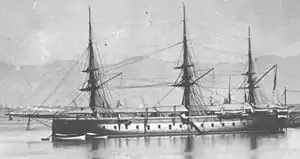Spanish ironclad Arapiles
The Spanish ironclad Arapiles was a wooden-hulled armored frigate bought from England during the 1860s for the Spanish Navy. Begun as an unarmored steam frigate, she was converted into an ironclad while under construction. Damaged when she ran aground in early 1873, she was under repair in the United States during the Virginius Affair later that year as tensions rose between the US and Spain over the incident. The ship was hulked in 1879 and the poor condition of her hull forced her reconstruction to be cancelled in 1882. Arapiles was scrapped a year or two later.
 Arapiles at anchor | |
| History | |
|---|---|
| Name | Arapiles |
| Namesake | Battle of Salamanca |
| Builder | Green, Blackwall, London |
| Laid down | June 1861 |
| Launched | 17 October 1864 |
| Completed | 1865 |
| Commissioned | 1868 |
| Stricken | 1879 |
| Fate | Scrapped, 1883 |
| General characteristics (as built) | |
| Type | Broadside ironclad |
| Displacement | 3,441 long tons (3,496 t) |
| Length | 280 ft (85.3 m) |
| Beam | 52 ft 2 in (15.9 m) |
| Draft | 17 ft (5.2 m) |
| Installed power | 2,400 ihp (1,800 kW) |
| Propulsion |
|
| Sail plan | Ship rig |
| Speed | about 8 knots (15 km/h; 9.2 mph) |
| Complement | 537 |
| Armament |
|
| Armor | |
Description
Arapiles was 280 feet (85.3 m) long at the waterline, had a beam of 52 feet 2 inches (15.9 m) and a draft of 17 feet (5.2 m). The ship displaced 3,441 long tons (3,496 t). She had a single trunk steam engine that drove the propeller using steam provided by six boilers that exhausted through a single funnel. The engine was designed to produce a total of 2,400 indicated horsepower (1,800 kW) which gave the ship a speed of 8 knots (15 km/h; 9.2 mph).[1] For long-distance travel, Arapiles was fitted with three masts and ship rigged.[2]
The ship was armed with two Armstrong 10-inch (254 mm) and five 8-inch (203 mm) rifled muzzle-loading guns as well as ten 68-pounder smoothbore guns.[3] Sources differ on the exact thicknesses and extent of her wrought-iron armor, but agree that it ranged from three to five inches (76 to 127 mm) in thickness.[2]
Construction and career

Arapiles, named for the hills at the Battle of Salamanca, was built by Green at their shipyard in Blackwall, London. She was laid down in June 1861 as an unarmored frigate, but began her conversion into an ironclad in August 1862[4] when roughly 200 long tons (203 t) of armor was added.[5] The ship was launched on 17 October 1864 and completed the following year.[4]
Arapiles ran aground in early 1873 off the Venezuelan coast and was sent to Brooklyn, New York for repairs that lasted from May to January 1874. During the Virginius Affair later that year, a lighter sank, blocking the drydock gates in which Arapiles was being repaired as tensions rose between the United States and Spain. The ship was hulked in 1879 and her reconstruction was cancelled when the poor condition of her hull was noted in 1882.[4] She was broken up a year or two later.[2]
Memorial

She is commemorated by a bas relief, on the side of the statue of Richard Green who died while she was still under construction in his shipyard. The statue stands outside the Poplar Baths in London.[6]
Footnotes
- Silverstone, p. 388
- "Spanish Ironclads Tetuan, Mendes Nunes and Arapiles", p. 408
- de Saint Hubert
- Silverstone, p. 392
- Gardiner, p. 381
- "Richard Green statue". PMSA Public Monuments & Sculpture Association. Archived from the original on 6 October 2014. Retrieved 12 May 2018.
References
- Brassey, Thomas (1888). The Naval Annual 1887. Portsmouth, England: J. Griffin. OCLC 669097244.
- Lyon, Hugh (1979). "Spain". In Gardiner, Robert (ed.). Conway's All the World's Fighting Ships 1860–1905. Greenwich: Conway Maritime Press. pp. 380–386. ISBN 0-8317-0302-4.
- de Saint Hubert, Christian (1984). "Early Spanish Steam Warships, Part II". Warship International. XXI (1): 21–45. ISSN 0043-0374.
- Silverstone, Paul H. (1984). Directory of the World's Capital Ships. New York: Hippocrene Books. ISBN 0-88254-979-0.
- "Spanish Ironclads Tetuan, Mendes Nunes and Arapiles". Warship International. XI (2): 407–408. 1974. ISSN 0043-0374.